[021] A day with grebes
[021] A day with grebes, testo e foto by
Juza. Pubblicato il 08 Giugno 2012; 1 risposte, 4037 visite.
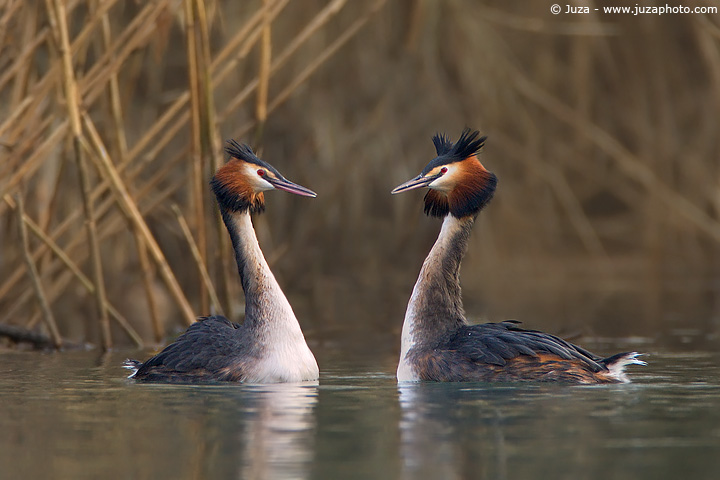
Canon EOS 20D, Canon EF 600mm f/4 L IS USM, Canon 1.4x TC, 1/400 f/5.6, iso 800, support. Sile River, Italy.
Laying flat on the ground, side by side with my friend Fenice, I had the luck to admire the elegant courtship dance of a couple of grebes. As every time that I photograph a water bird, I tried to place the lens as low as possible: luckly, we found a quay along the Sile river, where we could get almost at water level, placing the lenses directly on the ground. Since the grebes where quite distant (nearly 60 meters from us), I mounted the 1.4x TC on the 600 f/4, to get an effective focal length of 840mm.
The Great Crested Grebe (Podiceps ruficollis) is the Europes largest grebe: it is 45-60 centimeters long and it has a 60-70 cm wingspan. In 1800s, it was hunted for plume trade (its head plumes were used ad decoration) and it was almost extint in many areas of Europe, but nowadays it is again common, and it is quite easy to see it in lakes, swamps, rivers and coastlines. In the branch of Sile river near Silea (Italy), we have seen six grebes; two pairs had already begun their courship behaviour, even though we are still in winter (but this winter in Italy is unusually warm, and many animals have altered their behaviours).
Usually during the winter the plumage has large white areas, with a small black cap on its head, while during the rest of the year it has darker tones and a beautiful red and black crest, that sometimes it erects in display. It is not a great flyier, but if you have the occasion to see it in flight you notice the pale areas on the wings. The beack has a pink/magenta tone, and the bright red eye stands out from the white feathers of the face. The juveniles are easility recognized thanks to their striped (back and white) plumage.
The grebe is an excellent diver: we often see it disappearing underwater for almost one minute to catch fishes, crustaceans and other preys - sometimes, it catches even quite large fishes. Usually it catches its preys at a depth of 2/4 meters, but it is able to reach much deeper waters, even -20/30 meters. During the dives, it swims thanks its large feets, and it quickly catches its poor prey. Even when it is endangered, it prefers to swim instead of flying away; it is able to swim underwater for more than 100 meters, while in flight it loses its grace. Sometimes we have observed it running on water, like coots.
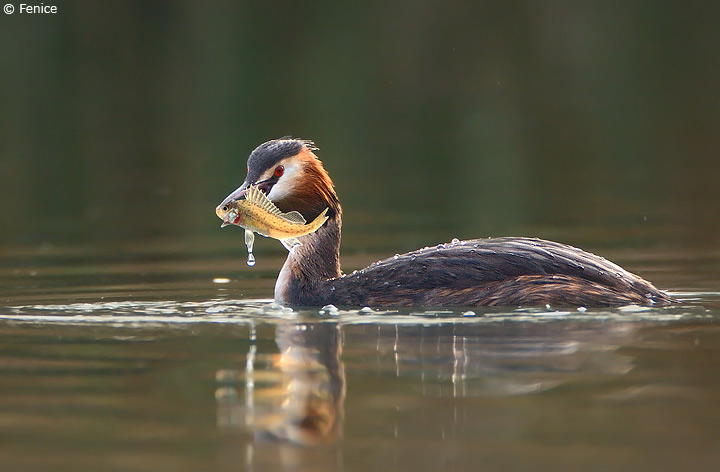
Canon EOS 20D, Canon EF 600mm f/4 L IS USM, Canon 1.4x TC, 1/400 f/5.6, iso 400, support. Sile River, Italy.
Its elegant and elaborate courship display is a joy for the eyes of every nature lover. The male raises its peculiar creast and makes a calling; when the female aswers and joins him, they shakes their head from side to side. Sometimes they stop for a moment and each grebe stare to its partner. The couple that we observed was quite distant - the grebes are a little less tolerant to human presence than other water birds as mallards, coots or swans, and usually the best strategy to photograph them is to stay still and waiting that they come close - if you try to walk closer, it is likely that they be scared away. The wide aperture of the big supertele helped me a lot to create a decent separation from the birds and the background. I focussed on the neck with the center AF point, then I locked the AF with the star button and I recomposed the image: I often use this tecnique when the bird are relatively still; remember that on Canon cameras to use the * button as AF lock you have to set the custom function 4 on the setting number two (AF/AF Lock - no AE Lock).
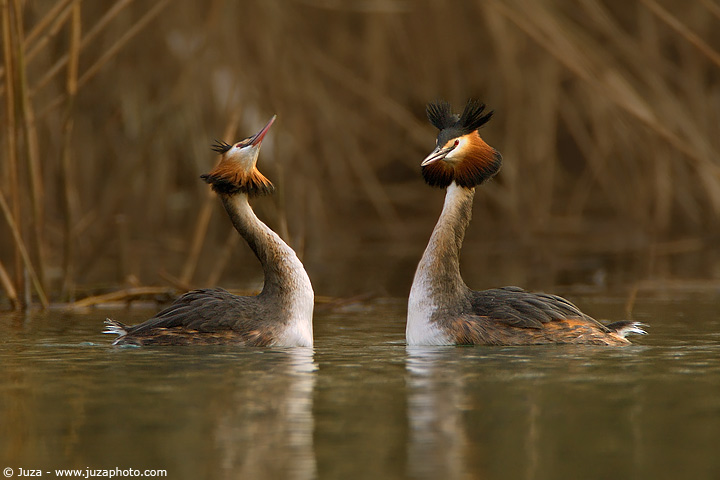
Canon EOS 20D, Canon EF 600mm f/4 L IS USM, Canon 1.4x TC, 1/400 f/5.6, iso 800, support. Sile River, Italy.
There was not much light so I used ISO 800, and I underexposed by 0.7 stop to get a faster shutter speed and to preserve the whites. As always, I checked the exposure with the histogram to be sure that the subject was properly exposed. When I photograph birds and wildlife, I always prefer to raise ISO sensitivity rather than risking motion blur - with good Photoshop techniques, it is possibile to get excellent prints even from ISO 800 photos, while there is no way to save a blurred photo.
After the head shaking, the two grebes, in perfect syncrony, dived under the surface and reappeared with some pondweed in the bill. They quickly raised on the water by paddlying very quickly and they made a reciprocal excange of food. Quite a spectacle!
I didn't expeceted the action, but Fenice alerted me in time and I managed to grab a couple of shots. I had lowered the ISO to 400, but luckly the shutter speed of 1/500 was enough to stop the action.
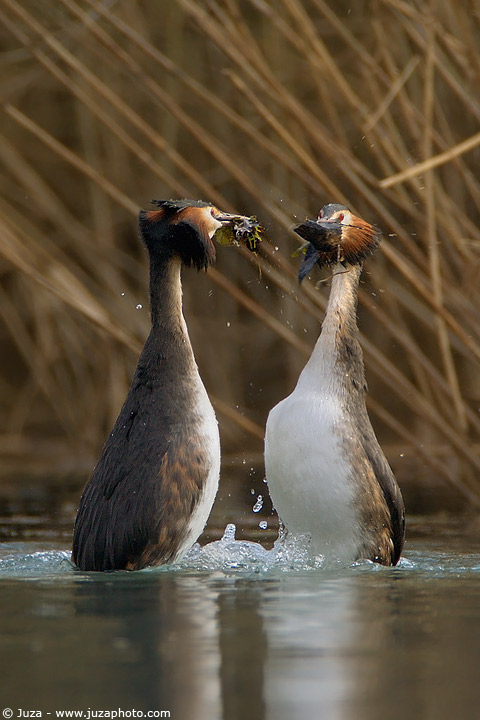
Canon EOS 20D, Canon EF 600mm f/4 L IS USM, Canon 1.4x TC, 1/500 f/5.6, iso 400, support. Sile River, Italy.
The purpose of this graceful courtship is not just the mating - that takes place some weeks after: the two grebes are trying to strengten their bonds of affection. Thanks to the frequent excanges of food and the elegant dances, they create a strong couple.
Later in the years, usually in March or April, the couple chooses a site for the nest, that usually is a floating structure built next to reeds, branches or other supports, close to the margins of river and lakes. The nest is created with dead water plants, weeds and mud; it is quite fragile, and it can be destroyed by inclement weather or my human activities. We were quite worried seeing some fishermen placing their boat next to the reeds, right in the place where we observed the courtship - let's hope that the grebes find a quiet place for their nest, where they can not be disturbed people.
Both the male and female incubate the eggs (usually 3-4 eggs, sometimes even five) for 28 days. The young, cute grebes are able to swim almost at hatching, but during the first two weeks usually they are carried around on the back of their parents. Usually a parent stays with the chicks while the other parent is out fishing; the chicks depends on their parents until they are 8-10 weeks old.
After photographing the courtship, we remained on Sile river until late morning. We have noticed that the grebes on Sile river are most active during the morning - indeed, Fenice has taken one of her best grebe photos at sunsire, surrounded by the silence and the warm light of the morning.
The following text is by Fenice.
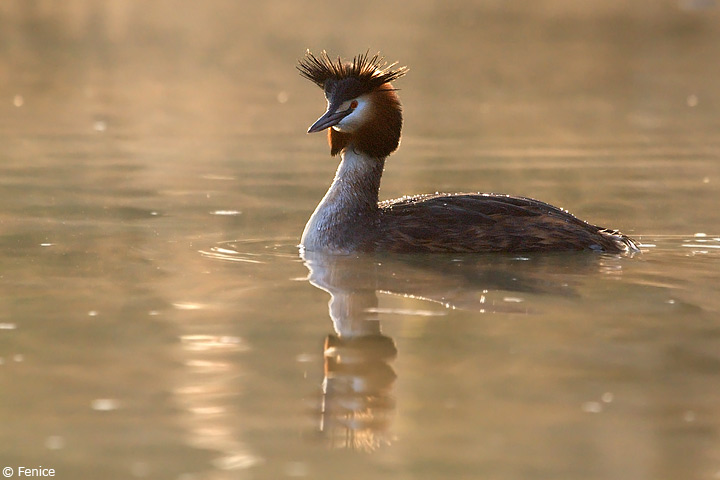
Canon EOS 350D, Canon EF 100-400mm f/4.5-5.6 L IS USM, 1/1000 f/5.6, iso 400, handheld. Sile River, Italy.
It was early morning when I (Fenice) arrived on Sile river. The grebes were almost in complete backlighting - but the light of sunrise was gorgeous, and I was determined to photograh a grebe swimming in the golden water. Lying flat on the ground with the Canon 100-400 L IS lens, I set the camera on ISO 400 (here, it was enough to get a fast shutter speed), and the aperture on f/5.6, the widest aperture available on this zoom at 400mm, to get a clean out of focus background. I selected the center AF area, to focus carefully on the eye of the subject. The versatility of the zoom helped me to find the subject into viewfinder and to frame it in a simple, but pleasing composition. I waited until the grebe come close and, when he turned a little the head towards me, I toke the photo. Risposte e commenti
Che cosa ne pensi di questo articolo?
Vuoi dire la tua, fare domande all'autore o semplicemente fare i complimenti per un articolo che ti ha colpito particolarmente? Per partecipare iscriviti a JuzaPhoto, è semplice e gratuito!
Non solo: iscrivendoti potrai creare una tua pagina personale, pubblicare foto, ricevere commenti, partecipare alle discussioni e sfruttare tutte le funzionalità di JuzaPhoto. Con oltre 257000 iscritti, c'è spazio per tutti, dal principiante al professionista.
| inviato il 24 Aprile 2018 ore 8:20
I really enjoyed reading this, thanks for sharing it. |






 JuzaPhoto contiene link affiliati Amazon ed Ebay e riceve una commissione in caso di acquisto attraverso link affiliati.
JuzaPhoto contiene link affiliati Amazon ed Ebay e riceve una commissione in caso di acquisto attraverso link affiliati.